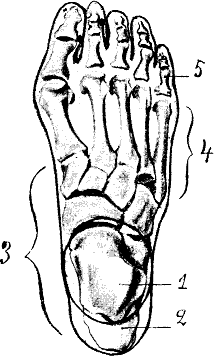Hallux rigidus: Difference between revisions
CSV import |
CSV import |
||
| Line 41: | Line 41: | ||
Treatment options for hallux rigidus vary depending on the severity of the condition and may include: | Treatment options for hallux rigidus vary depending on the severity of the condition and may include: | ||
* Non-surgical treatments: | * Non-surgical treatments: | ||
** [[Nonsteroidal anti-inflammatory drug|Nonsteroidal anti-inflammatory drugs]] (NSAIDs) to reduce pain and inflammation. | |||
** Physical therapy to improve joint mobility. | |||
** Custom orthotic devices to support the foot and reduce stress on the MTP joint. | |||
** Shoe modifications, such as stiff-soled shoes or shoes with a large toe box. | |||
* Surgical treatments: | * Surgical treatments: | ||
** Cheilectomy: Removal of bone spurs and part of the foot bone to improve joint movement. | |||
** Arthrodesis: Fusion of the MTP joint to eliminate pain by preventing joint movement. | |||
** Arthroplasty: Joint replacement surgery to restore function and relieve pain. | |||
==Prognosis== | ==Prognosis== | ||
The prognosis for individuals with hallux rigidus varies. Non-surgical treatments can often manage symptoms effectively, but in severe cases, surgery may be necessary to restore function and alleviate pain. Early diagnosis and treatment are crucial to prevent the progression of the condition. | The prognosis for individuals with hallux rigidus varies. Non-surgical treatments can often manage symptoms effectively, but in severe cases, surgery may be necessary to restore function and alleviate pain. Early diagnosis and treatment are crucial to prevent the progression of the condition. | ||
Latest revision as of 20:17, 7 April 2025

Editor-In-Chief: Prab R Tumpati, MD
Obesity, Sleep & Internal medicine
Founder, WikiMD Wellnesspedia &
W8MD medical weight loss NYC and sleep center NYC
| Hallux rigidus | |
|---|---|

| |
| Synonyms | Stiff big toe |
| Pronounce | N/A |
| Specialty | N/A |
| Symptoms | Pain and stiffness in the big toe, difficulty walking |
| Complications | Osteoarthritis |
| Onset | Usually after age 30 |
| Duration | Long-term |
| Types | N/A |
| Causes | Degenerative joint disease, trauma |
| Risks | Family history, foot anatomy, gout |
| Diagnosis | Physical examination, X-ray |
| Differential diagnosis | Gout, bunion, sesamoiditis |
| Prevention | Proper footwear, avoiding foot injuries |
| Treatment | NSAIDs, physical therapy, surgery |
| Medication | NSAIDs |
| Prognosis | Variable, can lead to arthritis |
| Frequency | Common |
| Deaths | N/A |
Hallux rigidus is a medical condition characterized by stiffness and pain in the metatarsophalangeal joint (MTP) of the big toe. It is a form of degenerative arthritis and can significantly impact a person's ability to walk and engage in physical activities.
Signs and Symptoms[edit]
The primary symptoms of hallux rigidus include:
- Pain and stiffness in the big toe, especially during walking or standing.
- Swelling and inflammation around the MTP joint.
- Difficulty in bending the big toe.
- Development of bone spurs on the top of the MTP joint, which can lead to a bump that is painful and limits shoe wear.
Causes[edit]
Hallux rigidus is often caused by wear and tear of the joint over time. Factors that may contribute to the development of this condition include:
- Osteoarthritis.
- Previous injury to the big toe.
- Abnormal foot anatomy or biomechanics.
- Genetic predisposition.
Diagnosis[edit]
Diagnosis of hallux rigidus typically involves:
- A physical examination of the foot.
- X-ray imaging to assess the extent of joint degeneration and the presence of bone spurs.
- Magnetic resonance imaging (MRI) or computed tomography (CT) scans in more complex cases.
Treatment[edit]
Treatment options for hallux rigidus vary depending on the severity of the condition and may include:
- Non-surgical treatments:
- Nonsteroidal anti-inflammatory drugs (NSAIDs) to reduce pain and inflammation.
- Physical therapy to improve joint mobility.
- Custom orthotic devices to support the foot and reduce stress on the MTP joint.
- Shoe modifications, such as stiff-soled shoes or shoes with a large toe box.
- Surgical treatments:
- Cheilectomy: Removal of bone spurs and part of the foot bone to improve joint movement.
- Arthrodesis: Fusion of the MTP joint to eliminate pain by preventing joint movement.
- Arthroplasty: Joint replacement surgery to restore function and relieve pain.
Prognosis[edit]
The prognosis for individuals with hallux rigidus varies. Non-surgical treatments can often manage symptoms effectively, but in severe cases, surgery may be necessary to restore function and alleviate pain. Early diagnosis and treatment are crucial to prevent the progression of the condition.
Prevention[edit]
Preventive measures for hallux rigidus include:
- Wearing appropriate footwear that provides adequate support and room for the toes.
- Avoiding activities that place excessive stress on the big toe.
- Maintaining a healthy weight to reduce pressure on the feet.
- Performing regular foot exercises to maintain joint flexibility and strength.
See Also[edit]
References[edit]
<references group="" responsive="1"></references>
External Links[edit]
